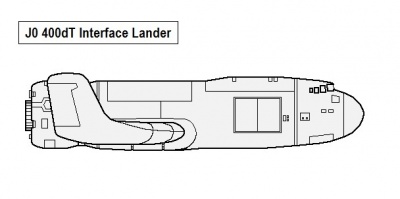Omicron class Heavy Lander
| Omicron class Heavy Lander | |
|---|---|
 Distant Fringe vessel | |
| Type: RK Transport | |
| Category | ACS |
| Size | 400 Tons |
| Hull Configuration | Cone Hull |
| Streamlining | Streamlined Hull |
| Tech Level | TL–9 |
| Engineering | |
| Computer | Model/1 |
| Jump | J-0 |
| Maneuver | 2 G |
| Armaments | |
| Hardpoints | 4 |
| Accommodations | |
| Staterooms | 4 |
| Low Berths | 10 |
| Personnel | |
| Crew | 6 |
| High/Mid Passengers | 0 |
| Low Passengers | 10 |
| Payload | |
| Cargo | 300 Tons |
| Fuel tank | 8 Tons |
| Construction | |
| Construction Time | 16 Months |
| Origin | Distant Fringe |
| Price | |
| Cost | MCr113.936 |
| Architect fee | MCr1.14 |
| Statistics | |
| Quick Ship Profile | RK-4S20 |
| Universal Ship Profile | RK–4202211–060000–00000-0 |
| Images | |
| Blueprint | No |
| Illustration | Yes |
| Source | |
| Canon | Unpublished, fan design |
| Designer | Ade Stewart |
| Design System | High Guard |
| Era | 1105 |
| Reference | Fan: Ade Stewart |
The Omicron class Heavy Lander is a TL–9 transport and interface craft.
- Please also see AAB article: Ships of the Distant Fringe.
Description (Specifications)
The Interface Lander is designed to ferry cargo and fuel between a world’s surface and close orbit. It is a common in-system transport vessel within the Distant Fringe and is frequently carried as a subcraft aboard large commercial vessels. Similar designs have been in use from the time the Distant Fringe was first settled.
Image Repository
- An Omicron class Heavy Lander in side view.

Basic Ship Characteristics
Following the Imperial Navy and IISS Universal Ship Profile and data, additional information is presented in the format shown here. The small craft factor indicates the number of squadrons (of ten subcraft) carried on the ship. Tonnage on the universal ship profile is shown in kilotons (thousands of tons) where necessary. [1]
| No. | Category | Remarks |
|---|---|---|
| 1. | Tonnage | The Interface Lander is constructed using a 400 dTon hull built in a generally cone-shaped configuration. The hull is fully streamlined and has airfoil surfaces, giving improved atmospheric performance that is further enhanced by its onboard gravitic systems.
|
| 2. | Crew | Total Crew Complement: x6
Accommodations
There are 10 Low Berths. Accessible areas of the hull are fitted with grav plates and inertial compensators and have full life support and environmental systems.
|
| 3. | Performance | The vessel mounts a Maneuver-2 drive and a Power Plant-2, giving performance of 2-G acceleration and producing 8 Energy Points. The ship has an agility rating of 2. The internal fuel tankage gives the power plant 4 weeks duration.
|
| 4. | Electronics | Adjacent to the bridge is a Model/1 Computer: no backup computer is installed.
|
| 5. | Hardpoints | x4 hardpoints. |
| 6. | Armament | The Interface Lander is generally unarmed. |
| 7. | Defenses | The hull is unarmored.
|
| 8. | Craft | The vessel carries no subcraft. |
| 9. | Fuel Treatment | The vessel has internal fuel tankage of 8 dTons.
|
| 10. | Cost | The basic cost of the vessel is MCr142.420.
|
| 11. | Construction Time | 64 weeks (16 months) as standard.
|
| 12. | Comments | Standard cargo capacity amounts to 300 dTons.
|
History & Background (Dossier)
The Omicron class is an interface craft primarily designed to shuttle fuel, cargo and sundries between a worlds surface and close orbit. It is frequently used as an in-system transport, carrying equipment and supplies to secondary worlds within a system. The design is representative and a large number of variants exist, particularly with regard to the allotted weapons systems, onboard electronics, and the fit out of internal spaces.
Selected Variant Types & Classes
3 Representative Transport (RK) Classes
References
| This article has metadata. |

|
This ship was originally designed using one of the Classic Traveller ship design rules:
|
- Author & Contributor: Lord (Marquis) and Master Scout Emeritus Adie Alegoric Stewart of the IISS
- ↑ Timothy B. Brown. Fighting Ships (Game Designers Workshop, 1981), 10.
- ↑ Timothy B. Brown. Fighting Ships (Game Designers Workshop, 1981), 10.